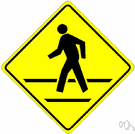 Here is information from a Seattle Police Department brochure titled ‘Pedestrian Safety Program’.
Here is information from a Seattle Police Department brochure titled ‘Pedestrian Safety Program’.
The laws that govern what is legal/illegal as they pertain to crossing the street are governed by the Seattle Municipal Code. These are non-criminal infractions that begin with a $46 fine and go up from there. The following are the most common infractions. For more information on SMC codes go to http://clerk.ci.seattle.wa.us/.
SMC 11.40.060 Prohibited crossing
It is illegal to suddenly leave the curb or sidewalk in front of a car that is so close it is impossible for the driver to stop the car before hitting you.
SMC 11.40.040 Right-of-way in crosswalk
When traffic-control signals are not in place or not operating, a driver must stop when they see a pedestrian crossing at an intersection or unmarked cross walk when that person is in the half of the roadway that the car is traveling or approaching the vehicle lane.
SMC 11.40.100 Prohibited crossing near signals
No pedestrian shall cross the roadway between adjacent intersections at which traffic-control signals are in operation, except in a marked crosswalk.
SMC 11.50.120 Steady yellow signal – pedestrian duties
Pedestrians facing a steady circular yellow or yellow arrow signal, unless otherwise directed by a pedestrian-control device, shall not enter the roadway, but if pedestrians have begun to cross before the display of the signal, vehicle operators shall stop to allow them to complete their movements.
SMC 11.50.160 Steady red signal – pedestrian duties
Pedestrians are prohibited from entering the street when facing a lone steady circular red or red arrow signal.
SMC 11.50.280 “Don’t Walk” pedestrian-control signal
Pedestrians facing a steady or flashing “DON’T WALK” sign shall not enter the roadway, but if pedestrians have begun to cross before the display of the signal, vehicle operators shall stop to allow them to complete their movements.
Tips
- Always walk on the sidewalk. If there is no sidewalk and you must walk in the roadway, always walk facing the traffic.
- See and be seen. Wear bright or light-colored clothing and make eye contact with the driver before proceeding through the crosswalk.
- Be careful when you see a driver attempting to make a right-hand turn. A large number of pedestrian accidents occur when drivers forget to recheck the crosswalk before proceeding.
- Cross the street only at marked crosswalks or intersections. This helps motorists to see you.
- When crossing a multiple-lane roadway, visually clear each lane as you proceed.
- Beware of parked cars: look for a driver who may not see you and pull out.
- Be Aware – Telephone poles, utility boxes and parked vehicles block oncoming drivers’ ability to see you.
- Stop before you enter the street. Look LEFT-RIGHT-LEFT prior to entering the street.
- Give drivers ample time to stop prior to entering the crosswalk.
Pedestrian Safety Tips for Children
- Teach children how to watch for cars backing out of driveways and parking spots.
- Teach children to turn off their headphones and cell phones while crossing the streets so they can hear approaching traffic.
- Teach kids to never dart out from between cars or run across dark streets to catch a bus. It is almost impossible for drivers to react in time.
- Always hold a child by the hand while crossing the street and remember – WALK DON’T RUN.
- Whenever possible, cross at a corner with the traffic light.
- Stop on the curb, not on the side of the street.
- Look LEFT – RIGHT – LEFT
Did you know?
- 5,000 pedestrians are killed each year in the U.S.
- 68,000 pedestrians were injured in 2004.
- On average, a pedestrian is killed every 113 minutes and injured every 8 minutes.
- 79% of pedestrian fatalities occurred at non-intersection locations.
- 89% of pedestrian fatalities occurred in normal weather conditions.
- 66% of pedestrian fatalities occurred at night.
- 69% of pedestrian fatality victims are males.
- 19% of all pedestrian fatalities are children between ages 5 and 9.
- Women, ages 70-79, have the highest pedestrian fatality rate of any other age group.


Leave a Reply